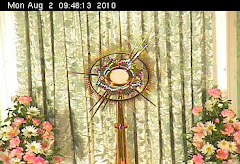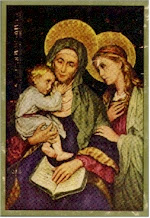
Here's a little follow-up to my last post on the Sanctuary lamp:
The Altar
The altar is one of the most important parts of a church and is frequently situated on an elevated area called the sanctuary or ‘holy place’. Of course the sanctuary had a more clearly defined area before the removal of the altar rails. It is in this ‘sacred place’ on the altar where the ‘sacrament of sacraments’ is celebrated, the holy sacrifice of the Mass. The altar is also the table of the Lord to which all are invited, as one family around the family table (Catechism of the Catholic Church 1182).
The Tabernacle
This is also holy because the Lord who is present in the Blessed Sacrament is kept here to foster adoration of the faithful. (CCC 1183)

The Chair
The Chair of the Bishop or Priest should express his office of presiding over the assembly and of directing prayer. (CCC 1184)
 The Ambo/Lectern
The Ambo/Lectern
The dignity of the Word of God requires the church to have a suitable place for announcing this message so that the attention of the people may be easily directed to that place during the Liturgy of the Word.
I hope some readers find these little snippets of information helpful. It's easy to assume that everyone is familiar with the terminology of the Church and understands the meaning of the signs and symbols that some of us take for granted.











